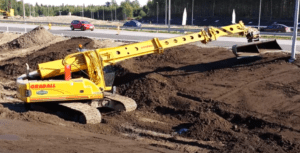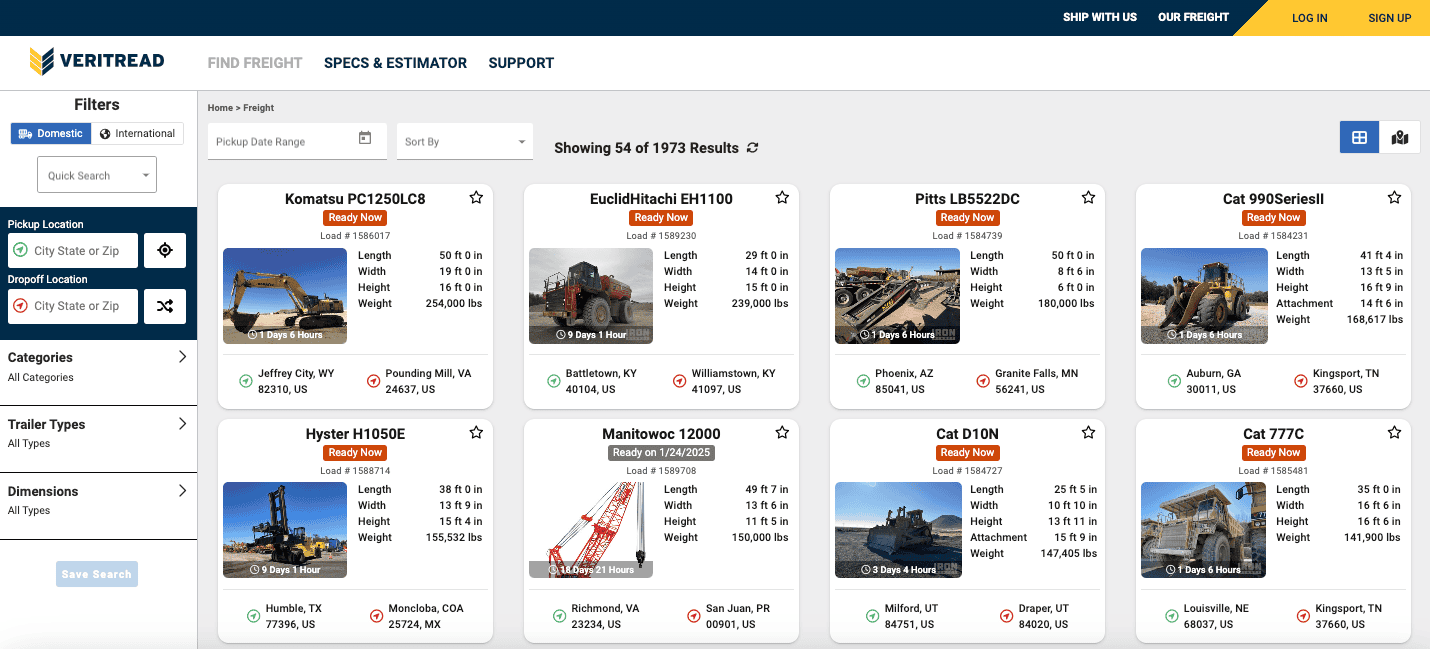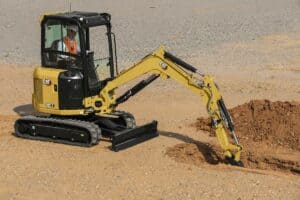What is an Excavator?
What is an Excavator?

An excavator is a large, diesel-powered construction machine made for digging out earth with its bucket to create trenches, holes and foundations. It’s a major component of large construction jobsites.
Simply by swapping out the bucket for another attachment, this piece of excavation equipment can also drive piles, clear brush, load and dump, grade a jobsite and perform other heavy-duty jobsite tasks.
When transporting an excavator, you need to take proper care to ensure these valuable pieces of equipment are not damaged. Everything from the right type of trailer, the loading process, and transportation are critical. You must also take into account the proper local and national regulations you have to abide by.
Finding a transport company that knows how to load an excavator safely and securely is crucial to a successful transport journey.
What are the different types of Excavators?
There are many types of excavators — smaller machines handle digging and drilling functions, while larger excavators have different tools for heavy-duty projects.
1. Crawler Excavators

Unlike smaller excavators that run on wheels, crawlers run on two large endless tracks and are optimal for mining and heavy-duty construction jobs. Also known as track hoes, these excavators use hydraulic power mechanisms to lift heavy debris and soil and are the workhorses of most job sites.
2. Wheeled Excavators
Wheeled excavators are smaller in appearance to crawlers but run on wheels instead of tracks. Replacing tracks with wheels makes them faster and easier to maneuver on concrete, asphalt and other flat surfaces while still offering the same power capabilities. Wheels offer less stability on uneven ground than tracks, so wheeled excavators are commonly used for roadwork and urban projects.
3. Dragline Excavators
The dragline excavator is a larger excavator that utilizes a hoist rope system that attaches to a bucket via a hoist coupler. The other side of the bucket affixes to a dragline that runs from the bucket to the cab. The hoist rope raises and lowers the bucket while the dragline pulls the bucket toward the driver.
4. Mini Excavators
A mini excavator is a smaller and lighter version of the standard excavator capable of minimizing ground damage and fitting through crowded, narrow sites like parking lots and indoor spaces. Also known as compact excavators, mini excavators typically incorporate reduced tail-swing or zero tail-swing to maneuver tighter turns and avoid contact with any obstacles.
5. Long Reach Excavators
A long reach excavator features lengthier arm and boom sections, this design allows for better operation in hard-to-reach locations. The excavator’s extendable arm can reach over 100 feet horizontally. These excavators are best used for demolition projects like structural crumpling and breaking down walls over bodies of water. Different attachments can be affixed to the arm to perform additional jobs such as shearing, crushing and cutting.
5. Gradall Excavators

Gradall Excavators have a unique boom and a cab attached to a rotating platform (the house), which sits on top of the tracks and wheels (the undercarriage).The boom on Gradall excavators is unique because it extends outward from the house and has been engineered to articulate in a way that’s similar to a human arm with wrist action, allowing it to move up, down and side to side with ease. It provides continuous boom force throughout the complete dig cycle with a 220 or 360-degree tilt to handle fine grading and sloping. Gradall’s power and versatility makes them a great choice for digging trenches and foundations and moving materials in challenging of environments. They’re also ideal for demolition projects, material handling, brush cutting, mining, river dredging and even snow removal.
What are the parts of an excavator?
Hydraulic cylinders, booms, arms and attachments provide digging and holding functionalities, while a house-like cab provides the driver with controls to direct the excavator. A rotating platform and wheels provide the necessary mobility to lift and remove debris from the worksite. The versatility of an excavator is why this piece of equipment is on almost every jobsite.

Choosing the right Excavator transport provider
Loading and transporting an excavator has several logistical challenges. This is a tedious task that needs proper planning for the cargo to reach its destination successfully and safely. With this type of transportation, it’s important to work with trusted service providers.
You will want to go with an open deck trailer like a flatbed, step deck, or removable gooseneck (RGN). Typically, an excavator will be an oversize load, which will require you to use a larger trailer like a lowboy or RGN. When it comes to heavy equipment transport, you’ll have to educate yourself with different regulatory requirements – like weight and size restrictions. When it comes to loading and transporting an excavator, it’s possible to minimize the challenges by following these three key processes:
Choose an appropriately-sized towing vehicle
Follow recommended loading procedures
Securing the excavator
Why choose VeriTread for Excavator Transport?
VeriTread is here to provide top-notch excavator transportation. We are committed to improving and streamlining the excavator transportation process. VeriTread moves thousands of machines every year and can quickly generate a reliable estimate on the go. Our extensive specs and dimensions database of 60,000+ items, ensures you spend less time researching and more time putting your equipment to work. The VeriTread Shipper quote process is the simplest way to receive competitive quotes from vetted transport providers. Follow these easy steps and you will receive a quote in under one minute:
- Select Ready To Ship from the Freight Options Page
- Enter a Manufacturer & Model
- Verify or Edit Your Machine Dimensions
- Enter Pickup & Drop Off Locations
- Your Quote is Ready!
If you have questions contact us at (800) 880-0468 or (863) 226-0903 and let our team of experts help you with your transport needs.
veritread products
Top Articles
Freight Types
recent posts

Basic Tips of Heavy Equipment Transport

Understanding Equipment Transport Services






